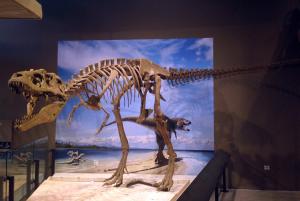 |
| The plate on the left contains about equal numbers of colonies of two different bacteria. After the bacteria compete and evolve, the lighter ones have taken the lead in the plate on the right. |
Evolution is relentless process that seems to keep going and going, even when creatures live in a stable, unchanging world.
That's the latest surprise from a unique experiment that's been underway for more than a quarter-century.
Evolution is so important for biology, medicine and a general understanding of our world that scientists want to understand it as fully as possible. That's why, in 1988, biologist Richard Lenski took a dozen glass flasks and added identical bacteria to each of them. Those 12 populations have been evolving ever since, letting scientists watch evolution in real time.
 |
| Michigan State's Richard Lenski pulls cultures of bacteria from a lab freezer. |
Day after day — including holidays and weekends — workers in Lenski's lab at Michigan State University in East Lansing feed and care for the E. coli bacteria. The bacteria eat and divide again and again. The original microbes have produced more than 50,000 generations over the last 25 years.
Random mutations have allowed them to get fitter, meaning they reproduce faster. "In evolutionary biology, fitness is this representation of the ability of an organism to survive and reproduce," says Lenski. He explains that all else being equal, organisms that reproduce more quickly will have an advantage when competing with those that reproduce more slowly.
Early on, Lenski predicted his bacteria would adapt and adapt but eventually hit a wall — that they would reach a peak level of fitness they couldn't improve on.
"Evolutionary biologists have long thought of evolution as a process that continues indefinitely because the world is constantly changing," says Lenski. But his bacteria live in an unchanging world — their glass bottles stay at a steady temperature and they constantly are fed the same food.
It turns out, though, that the bacteria haven't stopped evolving, and it looks like they never will, according to a report Lenski's group has now published in the journal Science.
Lenski, along with colleagues Michael Wiser and Noah Ribeck, dug into a freezer that holds samples of the bacteria that were taken every few months over the course of the whole experiment. The researchers can pull out, say, the 10,000th or 40,000th generation and bring these frozen bacteria back to life.
"We can actually compete organisms that lived at different points in time, so we can compete the evolved bacteria head to head against their ancestors," says Lenski.
What they've found is that the bacteria just keep getting fitter and fitter and fitter. The pace of improvement is slowing down, but shows no sign of stopping.
In their tests, the original ancestor doubles its population in about an hour, says Lenski, but the 50,000th generation can do that in around 40 minutes. And the researchers calculate that future generations will reproduce even faster. "We predicted that in about a million years, their doubling time might be on the order of about 20 minutes," says Lenski.
He says some bacteria can actually achieve that, in environments more rich in nutrients than the flasks in his lab, so it doesn't seem like a crazy, ridiculous prediction.
Still, that would be a lot of change for creatures living in an unchanging world, and it offers a new insight on how evolution can just keep on going and going.
Does Lenski think his long-term experiment will still be around in million years, to test his predictions? "I doubt it," he says.
But he would love to see it last another 25 years, at least. "I think it's still got a lot to teach us about how evolution works under these very idealized but very transparent conditions," says Lenski, who eventually plans to pass the experiment on to a younger scientist.










